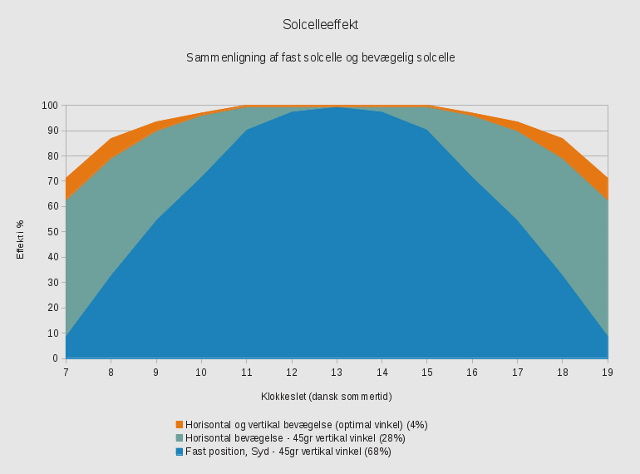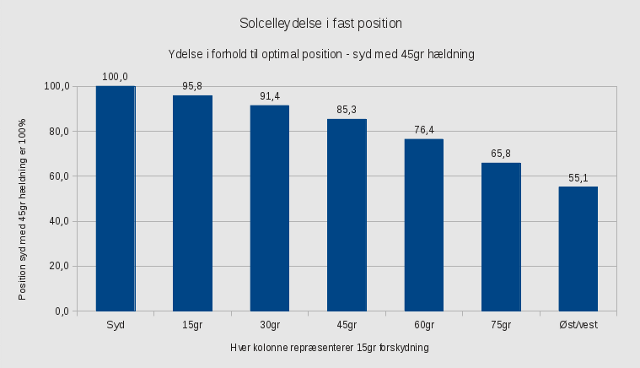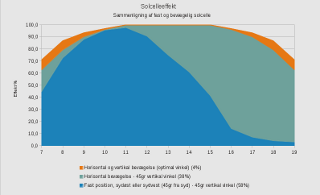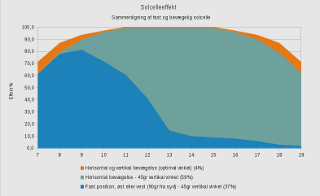Building a 12v computer supplied with power from a solar-panel - enabling it to be self sufficient thereby being able to be placed anywhere not depending on the power grid - I did some experiments and made some measurements of the efficiency of a solar-panel - primarily focusing on efficiency of the solar-panel when it is not placed in the ideal position. The graph (fig.1) shows the output power of a solar-panel placed on Falster in Denmark. The measurements were done through out the summer of 2012. The data shows average figures for three summer months.
The purpose of the measurements was to learn more about the aperture angle of a solar-panel - how much output power is lost when the solar panel does not face directly towards the sun and not in the ideal vertical angle.

fig. 1 Shows the difference between a fixed solar-panel facing due south with a vertical angle of 45 deg. and a solar-panel moving and programmed to follow the sun across the sky.
The graph above shows a comparison between a solar-panel in a fixed position due south with a 45 deg. vertical angle (the ideal fixed position at this latitude). And a solar-panel moving with the sun.
The data are registered over 12 hours from 7:00 in the morning and 19:00 in the evening (Danish daylight savings time).
As the graph shows it would, in the summer time, be possible to get some output from the solar-panel before 7:00 and after 19:00. I have not measured this and it would only be in a very ideal position where the view to the horizon at these hours are free that output could be gained.
The blue area in the graph shows the output from the solar-panel in the fixed position shown in percentage of the maximum output possible. The output in the fixed position is 68% of the maximum.
The green area shows how much more output could be gained if the solar-panel could move 180 deg horizontally from east to west, programmed to follow the sun's movement across the sky. The solar-panel still in 45 deg vertical angle. The solar-panel starts due eat at 7:00 and ends due west at 19:00. In this setup the output is increased to 96%.
The orange area shows how much more output could be gained if the solar-panel also could tilt vertically, enabling the solar-panel to stay in the optimum angle. In this case the last 4% output is gained.
As described above the percentage in fig.1 is percentage of the maximum possible output. If we instead converts the blue area to index 100 the total will be index 147. The effect of solar-tracking is the largest in the summer time, where also the energy that can be pulled from the sun by the solar-panels is the highest. An increase in the yearly output of 40%+ is likely.
One of the reasons for testing and measuring was to verify if solar-tracking could provide the 30%-40% increase in output, at this latitude, as promised by the solar-tracking companies in their sales material. I believe it is true - probably even a bit better at this latitude.
-------------------------------------
The graph below (fig.2) shows how much output is lost when installing the solar-panel in a fixed position (with a vertical angle of 45 deg). Each column shows the output of the solar-panel turned 15 deg at a time towards east or west.

fig. 2 Shows the output when the solar-panel is installed not due south. Each coloumn shows the output per 15 deg the solar-panel is installed away from due south until turned 90 deg facing due east or west.
These years a lot of solar-panels are installed on roofs in residential houses, unfortunately often not in a good position with solar-panels facing a not ideal direction with not the ideal tilt of the roof and with very little consideration of shadows from trees, buildings, etc. The use of resources is therefore often high when considering the output.
Establishing larger industrial park of solar-panels installed with a professional solar-tracking system like the one offered by Linak A/S and other companies would be a much better alternative. These parks would also be much easier to maintain and clean further increasing the superior efficiency from such a facility compared with the roof installations on residential houses. Considering the problems maintaining the roofs on residential houses just adds to the benefits of the larger facilities. And I won't even start commenting on the esthetic view of many of the roof installations....
Just for comparison with fig.1 - fig. 3 shows a fixed installations at south-east/south-west (45 deg from south) and fig.4 showing a fixed installation due east/west (90 deg from south) and comparing the fixed installation with a solar-tracking solution.





